2019 年 59 巻 1 号 p. 60-68
2019 年 59 巻 1 号 p. 60-68
The effects of an axial static magnetic field (ASMF) on the columnar to equiaxed transition (CET) during directionally solidifying GCr18Mo steel were investigated by experiment and numerical simulation. Experimental results show that the CET has been promoted by the increases of the magnetic field intensity and temperature gradient and the decrease of the growth speed. The corresponding numerical simulations verify that a thermoelectric magnetic convection in the melts and a thermoelectric magnetic force acting on the secondary dendrite neck are produced by the interaction between ASMF and a thermoelectric current. Compared the experimental results with the numerical simulations, the mechanism for the CET with ASMF demonstrates that the application of ASMF contributes to the transport of the fragments in the melts and detachment of dendritic side arms. Based on these results, we propose a process window for the CET of GCr18Mo steel with ASMF.
Adopting effective measures to promote the columnar to equiaxed transition (CET) during the solidification stage of steel have attracted much attention.1,2,3) Among the methods of promoting CET,4,5,6,7) stirring of the melt by time-varying magnetic fields is particularly attractive due to the completely contactless feature and flexible tailoring of the magnetic fields themselves.8,9,10,11) The flow induced by the melt stirring can penetrate the mushy zone, remelt the dendrite arms and decrease the temperature gradient in the melts, thus favoring the CET.12)
In contrast to the time-varying magnetic fields, static magnetic fields are always used to suppress the flow due to the braking effect of the Lorentz force.13) Based on the Seebeck effect, however, a thermoelectric magnetic convection (TEMC) can be induced in the mushy zone under the static magnetic field.14) It is attributed to a thermoelectric magnetic force (TEMF) acting on the melts. The TEMF results from interaction between the thermoelectric current (TEC) near the liquid/solid interface and the applied static magnetic field. On the other hand, the TEMF imposed on dendrites and equiaxed grains breaks the dendrites and drives the motion of dendrite fragments and equiaxed grains in the mushy zone.15,16,17) Obviously, above-mentioned effects result in a promotion of the CET.18) Therefore, the CET in the absence of inoculation substances was obtained in the directional solidification of Al-based alloys,19,20) Pb-Sn alloys18) and Ni-based superalloys21) under axial static magnetic field (ASMF). The effect of ASMF on the CET in GCr18Mo steel during directional solidification at low growth speeds (5–20 μm/s) has also been investigated in our previous work.22) The results have shown that the applied ASMF has enhanced the CET of GCr18Mo steel. However, the mechanism for the CET with ASMF is roughly described from a macro perspective. In addition, the CET in the steel under ASMF is affected by the local thermal parameters like the temperature gradient in the melts and the growth speed of the dendrites, together with the magnetic field intensity. Further effort is required to explore the process window and better control the parameters dominating and resulting the CET affected by ASMF in industry.
The goals of this work are described below. First, to assess the influence of the parameters on the CET, a heat-resistant Bridgman-Stockbarger type furnace has been installed in the static superconductor magnet. Since the intensity of the magnetic field, the temperature of the furnace and the growth speed could be controlled, the effects of the three parameters on the CET could be investigated independently. Second, the experimental results have been interpreted with the help of the numerical simulations performed with the software COMSOL. Third, combining both experimental and simulation results, a detail mechanism for the CET has been discussed. Finally, we attempt to give a process window for the CET of GCr18Mo steel with ASMF.
The material used in this work is a commercial GCr18Mo steel with chemical compositions (mass, %) of 0.96 C, 1.65 Cr, 0.2 Mo, 0.31 Si, 0.39 Mn, 0.0021S, 0.0027 P and balance Fe. The samples with a size of ϕ4 mm × 180 mm were wire electro-discharge machined from the steel ingots and enveloped in high purity corundum tubes with an inner diameter of 4 mm and length of 200 mm.
Directional solidification with ASMF was conducted with Bridgman liquid metal cooling technique in an argon environment. A schematic view of the directional solidification apparatus under an ASMF was shown in Fig. 1. The experimental facility consists of a superconducting magnet, a Bridgman-Stockbarger type furnace and a withdrawal speed and temperature controller. The superconducting magnet can generate the intensity of ASMF up to 8 T. The temperature of the heating zone can reach 1600 (±1)°C. During the directional solidification, the samples in the crucibles were melted and maintained for 30 min and then solidified in the Bridgman-Stockbarger type furnace by pulling the crucible assembly at various speeds with and without ASMF. To identify the morphology of the liquid/solid interface of samples, quenching experiments were performed after 60 mm steady-state growth of the specimens. More details regarding the experiment conditions are described in the work.22)
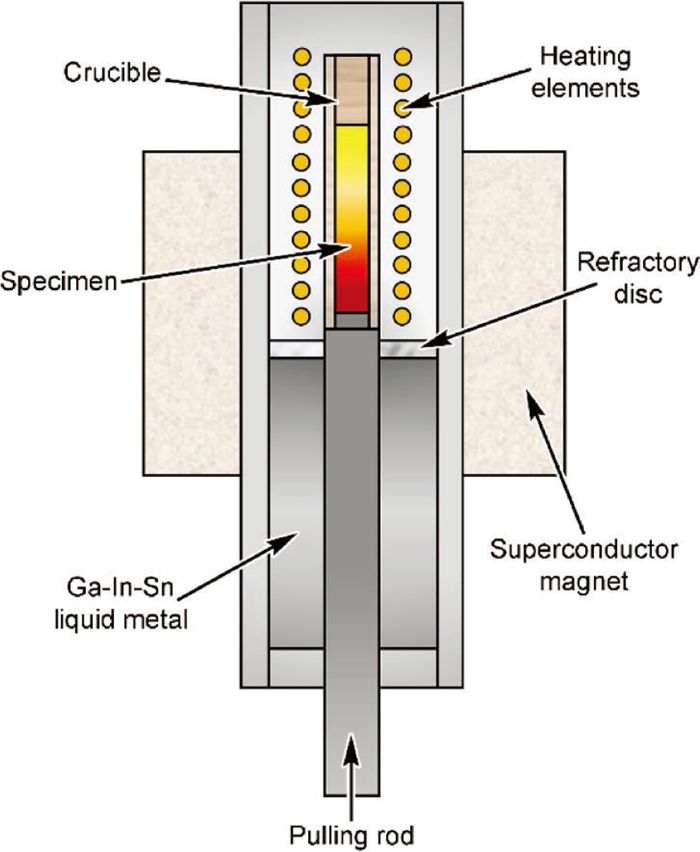
Schematic of the Bridgman solidification apparatus in a superconductor magnet. (Online version in color.)
The morphology of the solidification microstructures was observed by optical microscopy (DM 6000M, Leica, Germany). The samples were cut-across the longitudinal section, polished, and etched in saturated solution of picric acid at 80°C.
2.2. Simulative SetupThe numerical simulations just emphasize the effect of ASMF on the fluid flow without considering the heat transfer or the solidification process. With a fixed and given solid/liquid interface, a commercial finite element code COMSOL Multiphysics (5.3) is applied to solve this system in the liquid and solid phases simultaneously.
Figure 2 shows that microstructures of GCr18Mo steel at growth speed of 10 μm/s and various ASMF intensities under the 68 K/cm temperature gradient. With increasing intensity of ASMF, columnar grains gradually become equiaxed grains. When ASMF is applied, regular columnar dendrites are destroyed and tend to transform into equiaxed dendrites.

Longitudinal solidification microstructures near the liquid/solid interface of GCr18Mo steel specimen at growth speed of 10 μm/s and temperature gradient of 68 K/cm without (a) and with 0.5 T (b), 1 T (c), 2 T (d) and 4 T (e) axial static magnetic fields.
The dendrites are all regular at various temperature gradients without ASMF from the microstructures near the liquid/solid interface as displayed in Fig. 3. Columnar dendrites degenerate and transform into equiaxed dendrites as the temperature gradient increases with the 4 T ASMF.

Longitudinal solidification microstructures near the liquid/solid interface of GCr18Mo steel specimen at growth speed of 10 μm/s and temperature gradient of 68 K/cm (a, c) and 104 K/cm (b, d) without (a, b) and with 4 T (c, d) axial static magnetic fields.
The microstructures of directionally solidified GCr18Mo steel at various growth speeds under the 104 K/cm temperature gradient with and without ASMF are exhibited in Fig. 4. The dendrite morphology without ASMF is regular and columnar. With decreasing the growth speed under ASMF, columnar grains gradually become equiaxed grains.

Longitudinal solidification microstructures near the liquid/solid interface of GCr18Mo steel specimen at growth speed of 10 μm/s (a, e), 30 μm/s (b, f), 40 μm/s (c, g) and 50 μm/s (d, h) and temperature gradient of 104 K/cm without (a, b, c, d) and with 5 T (e, f, g, h) axial static magnetic fields (The letters B and G with the arrow indicate the direction of the magnetic field and the temperature gradient respectively.).
Longitudinal solidification structures of directionally solidified GCr18Mo steel at growth speed of 20 μm/s under the 68 K/cm temperature gradient without and with 4 T ASMF are shown in Fig. 5. The CET induced by ASMF tend to produce the grain refinement.
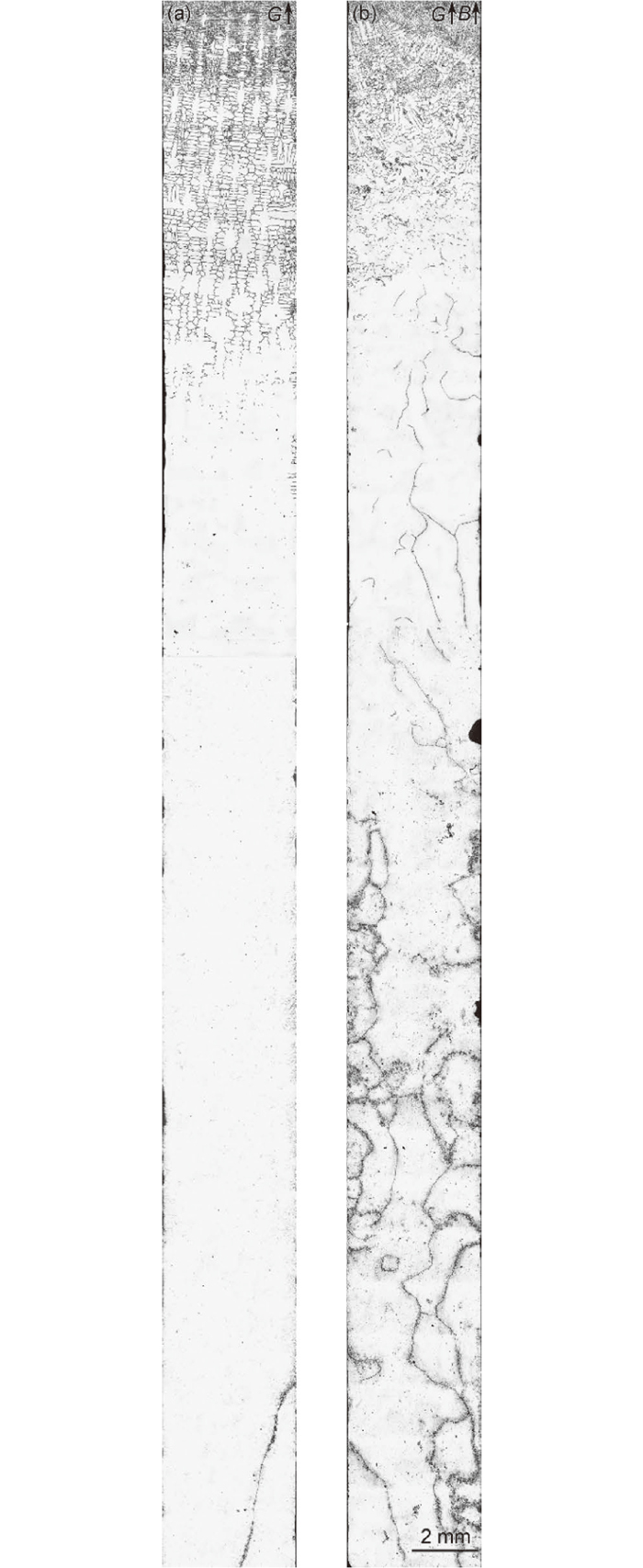
Longitudinal solidification structures of directionally solidified GCr18Mo steel at growth speed of 20 μm/s and temperature gradient of 68 K/cm without (a) and with (b) 4 T axial static magnetic fields.
Based on above experimental results, we perform numerical simulations on the TEMF imposed on dendrites and melts. To calculate the TECs at the solid/liquid interface during directional solidification, a complementary term is added to Ohm’s law:23)
| (1) |
Where j, σ, ∇V, S and ∇T are the TEC density, the electrical conductivity, the electric scalar potential, the absolute thermoelectric power and temperature gradient, respectively. S∇T is the contribution of the TEC. j satisfies the continuity equation:
| (2) |
From the electric current continuity, TEC should flow through the solid (s) and liquid (l) simultaneously, so that TEMF exists in both phases (Fs and Fl) with ASMF (B) and can be respectively expressed as:
| (3) |
| (4) |
The thermoelectric magnetic convection (TEMC) can be described by inserting an external volume force term to the Navier-Stokes equation:
| (5) |
| (6) |
Where ρ is the density, u denotes the velocity of the moving substance in a magnetic field, p is the pressure, g is the gravitational acceleration and μ stands for the dynamic viscosity.
It should be noticed that u×B must be taken into account due to the electromotive force induced by TEMC.
| (7) |
More details regarding the equations and corresponding boundary conditions are described in the works.23,24) Based on the assumption of Kurz,25) geometric model of the computation domain of the solid/liquid interfaces was built. A prescribed interface, as a heuristic model, qualitatively explains how the TEC and TEMF are produced. The physical properties of GCr18Mo steel used in the numerical simulation are given in Table 1.26,27,28)
| Parameter | Unit | Value in Solid | Value in Liquid |
|---|---|---|---|
| Absolute thermo-electric power (S) | V/K | −1×10−6 | −4×10−6 |
| Dynamic viscosity (μ) | Pa·s | − | 5.5×10−3 |
| Electrical conductivity (σ) | 1/(Ω·m) | 8.5×105 | 7.2×105 |
| Density (ρ) | Kg/m3 | 7.4×103 | 7.02×103 |
| Thermal conductivity (λ) | W/( m·K) | 32.5 | 31.2 |
Figure 6 shows the numerical simulation for TEMF in a typical columnar dendrite of the directionally solidified GCr18Mo steel at pulling rate of 20 μm/s and temperature gradient of 104 K/cm with 5 T ASMF. The geometry of the computation domain of the typical columnar dendrite is shown in Fig. 6(a). Figure 6(b) exhibits the distribution of the temperature. As shown in Fig. 6(c), the maximum density of the TEC appears in the secondary dendrite neck region. Figure 6(d) shows the distribution of the von Mises stress induced by TEMF in the typical columnar dendrite. This stress acts on the secondary dendrite neck.
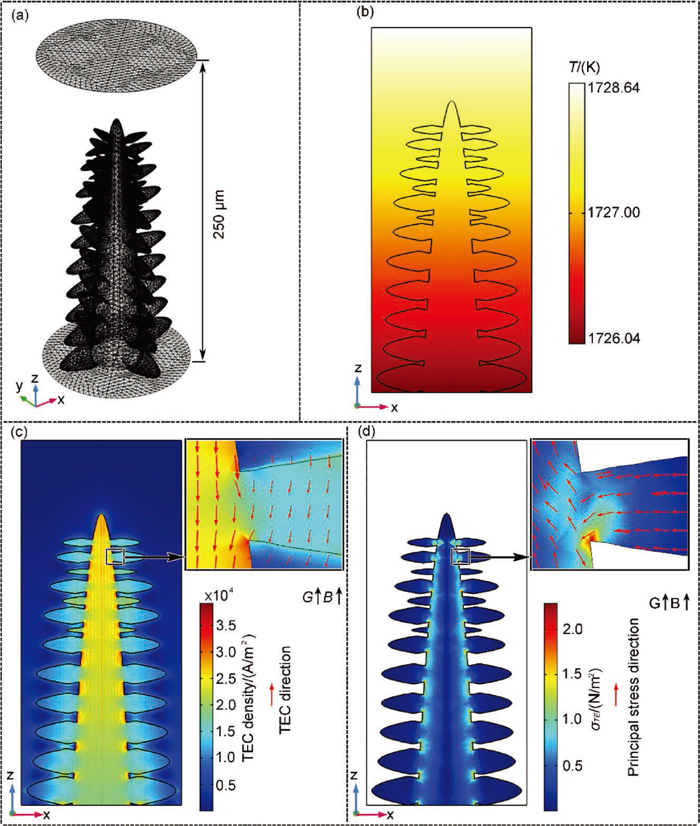
Numerical simulation for the thermoelectric magnetic force (TEMF) in a typical columnar dendrite of the directionally solidified GCr18Mo steel at growth speed of 20 μm/s and temperature gradient of 104 K/cm with 5 T axial static magnetic field: (a) Geometry of computation domain; (b) distribution of the temperature (T); (c) computed thermoelectric current (TEC); (d) distribution of the von Mises stress induced by TEMF (σTE—the magnitude of the von Mises stress). (Online version in color.)
Figures 7(a) and 7(b) show the geometry and the distribution of the temperature of the computation domain of regular solid/liquid interface at the growth speed of 50 μm/s and temperature gradient of 104 K/cm with the 5 T ASMF, respectively. The corresponding computed TECs in the liquid at the xz-plane are displayed in Fig. 7(c). The TEC forms the circuits along the cell and the large value of TEC density distributes around the dendrite tips and at the bottom of the mushy region. Figure 7(d) shows the general 3D view of the computed TEMC. Further examination into the fluid flow between the primary arms at yz-plane and the xy-plane is given in Figs. 7(e) and 7(f). Note that the fluid flows in a direction from the interdendritic spacing to the region ahead of the solidification front (Fig. 7(e)). In addition, a toroidal flow forms around the primary arm, and in the meanwhile a relatively high velocity appears along the edge of the sample (Fig. 7(f)). Furthermore, the distribution of the TEMC in the xz-plane is plotted in Fig. 7(g). It can be illustrated that the flow velocity increases along the positive z-axis. The reason for the small TEMC velocity at the large TEC density region in the bottom of the interdendritic spacing is that the direction of TEC is parallel to ASMF, not producing the TEMC (Eq. (5)).

Numerical simulation for the thermoelectric magnetic convection (TEMC) in the directionally solidified GCr18Mo steel at the growth speed of 50 μm/s and temperature gradient of 104 K/cm with the 5 T axial static magnetic field: (a) Geometry of computation domain; (b) distribution of the temperature (T); (c) computed thermoelectric current (TEC); (d) 3D view of computed TEMC; (e) computed TEMC at the yz-plane (x=0.2 mm) in the mushy zone; (f) computed TEMC at the xy-plane (z=3.8 mm) in the mushy zone; (g) Radial distribution of computed TEMC at different positions of the xz-plane in the mushy zone (VTE—the magnitude of computed TEMC). (Online version in color.)
For the mechanism of the CET without inoculants or any significant nuclei, Hellawell et al. defines five time- and temperature-dependent steps, starting with the detachment of side arms of primary arms in the mushy zone and ending with the blocking of the columnar front by a network of equiaxed grains.29) From this, we could deduce the mechanism of several keypoints: (1) dendritic side arms are separated from primary arms, (2) fragments are transported by interdendritic convection in the mushy zone, (3) fragments must survive and grow in the course, and (4) the advancing columnar solidification front is blocked by the these equiaxed grains reached a critical concentration. Under the action of ASMF, a Lorentz force, named as TEMF, affects the solidification processes ranging from a form of convection, transport of the solid phase in the liquid to strain and deformation of the solidified structure. For a given alloy, the TEMF (FTE) increases as the magnetic field intensity and the temperature gradient increase according to Eqs. (3) and (4).
On the one hand, the fragments in various alloys may be produced by several mechanisms: (1) ripening; (2) recalescence; (3) solute remelting of a dendrite neck; (4) mechanical deformation from various sources (gravity, buoyancy, liquid flow, and external deformation) combined with transgranular liquation cracking mechanisms; (5) catastrophic elastic remelting.30,31,32) Based on the catastrophic elastic remelting mechanism, the stress localized into the dendrite necks is induced by the TEMF, as another driving force for causing the dendrite to fragment (Fig. 6). On the other hand, the toroidal flow mainly exists in the interdendritic spacing of the mushy zone from the numerical results (Fig. 7). The fluid flow may transport some of the fragments from the interdendritic spacing to the region ahead of the solidification front (Fig. 7(e)). The advancing columnar front stops as soon as the concentration of the equiaxed grains has reached a critical value. Some other fragments may be trapped in the interdendritic spacing and then form new grains similar to Zimmermann’ analysis of the CET by using in-situ X-ray diagnostics.33) In addition, we have found that TEMF also cause a movement of equiaxed grains in suspension by using x-ray in situ and real-time observations under static magnetic field.34,35)
To gain more insight, the solidification microstructures and the maximum value of computed TEMC and the von Mises stress at various growth rates and magnetic field intensities under the temperature gradient of 104 K/cm are plotted in Fig. 8. The solidification microstructures obtained from the experiment show that the increase of magnetic field intensity contributes to the formation of equiaxed dendrites at relatively high growth speeds. The stress localized into the dendrite necks increases with increasing magnetic field intensity. In contrast with the stress, TEMC increases firstly and then decreases with increasing magnetic field intensity. However, the value of TEMC still above the growth speed. Notably, although there is a relatively high TEMC velocity under a low magnetic field intensity, no equiaxed dendrites have been formed at relatively high growth speeds. It may be attribute to the weak effect on the detachment of dendritic side arms induced by the stress localized into the dendrite necks.

The solidification microstructures and the maximum value of computed TEMC and the von Mises stress in the directionally solidified GCr18Mo steel at various growth speeds and axial static magnetic field intensities under the temperature gradient of 104 K/cm. (Online version in color.)
On the basis of the above results and analysis, we illustrate that how the solidification structure evolves at different solidification stages without and with ASMF (Fig. 9). As shown in Fig. 9, the columnar dendrites grow steadily and then finally form columnar grains without ASMF. When ASMF is applied, the fragments detach from the primary dendrites induced by the stress localized into the dendrite necks. Then the TEMC existed in the interdendritic spacing transports a part of the fragments from the interdendritic spacing to the region ahead of the solidification front, especially along the edge of the sample. As solidification progresses, these fragments grow up ahead of the columnar dendrite tips or in the interdendritic spacing. The advancing columnar solidification front will be blocked as soon as the concentration of the equiaxed crystals reaches a critical value. In this situation, most of the fragments tend to form new equiaxed grains.
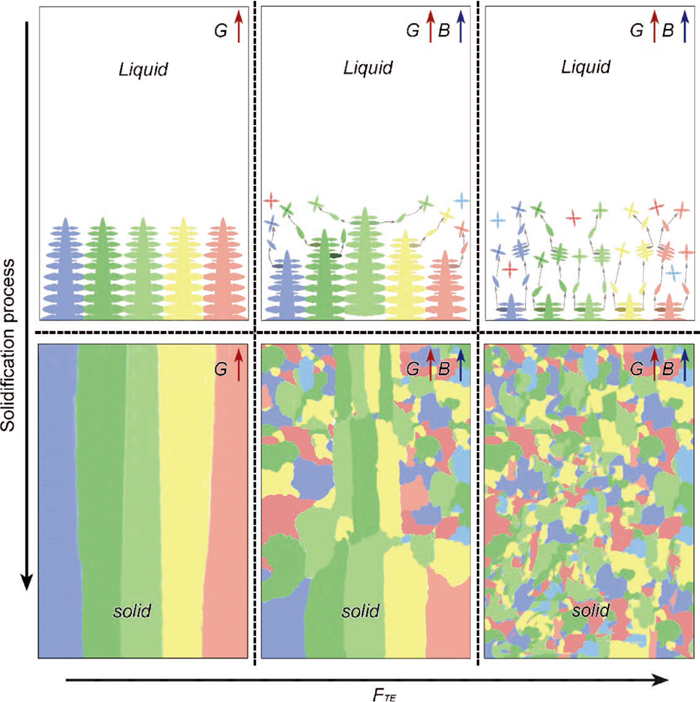
Schematic illustration of the columnar to equiaxed transition in the directionally solidified GCr18Mo steel without and with the axial static magnetic field (FTE—thermoelectric magnetic force). (Online version in color.)
Hunt initially established the criterion of the CET.12) Fully equiaxed growth occurs when
| (8) |
The structure is fully columnar when
| (9) |
Constitutional undercooling ΔTc is defined by Eqs. (10) and (11):
| (10) |
| (11) |
| Parameter | Unit | Value |
|---|---|---|
| Heterogeneous nuclei density (N0) | m−3 | 9×108 |
| Supercooling necessary for nucleation(∆TN) | K | 1.5 |
| Diffusion coefficient (D) | m2/s | 4.79×10−9 |
| Partition coefficient (k) | − | 0.34 |
| Liquidus slope (m) | K/wt% | –78 |
| Gibbs-Thomson parameter (Γ) | K·m | 1.9×10−7 |
Figure 10 shows microstructure selection map for GCr18Mo steel calculated by the Hunt’s model (a) and experimentally obtained from the 0 T (b), 1 T (c), 2 T (d), 4 T (e) and 5 T (f) ASMFs, when the imposed temperature gradient (G) or growth speed (V) are varied. The experimental results without ASMF (b) is consistent with the calculation from the Hunt’s model (a), when the temperature gradient and growth rate in the black dotted bordered rectangle are applied. The increasing magnetic field intensity contributes to extend the range for process parameters (G and V) of equiaxed grains formed. As in directional growth, the product, G·V, is equivalent to the cooling rate,
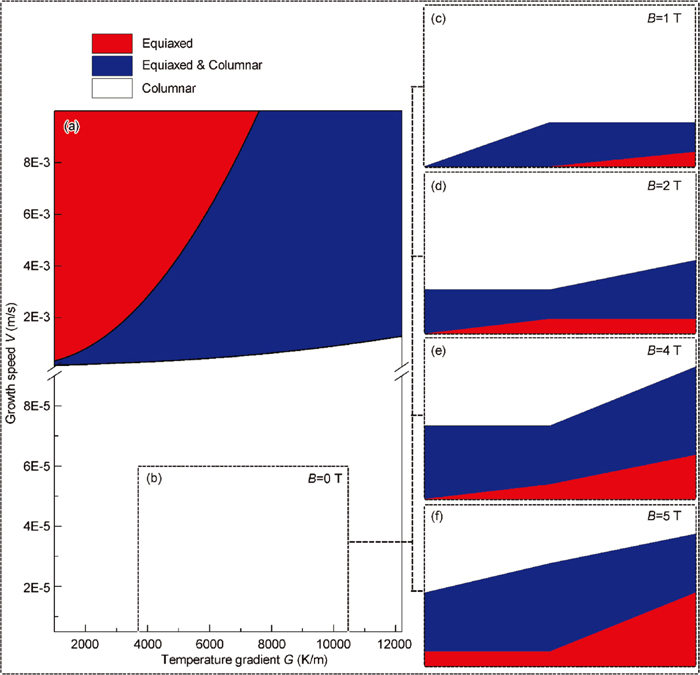
Microstructure selection map for GCr18Mo steel calculated by the Hunt’s model (a) and experimentally obtained from the 0 T (b), 1 T (c), 2 T (d), 4 T (e) and 5 T (f) axial static magnetic field intensities, when the imposed temperature gradient or growth speed are varied. (Online version in color.)
(1) With the application of ASMF, the temperature gradient, the growth speed and magnetic field intensity are the most crucial parameters which govern the solidification microstructure of GCr18Mo steel. The CET is enhanced with the increases in the magnetic field intensity and temperature gradient and the decrease in the growth speed.
(2) Combined with the experimental results, a numerical simulation was proposed to explore the mechanism of the CET with ASMF. The TEMF affects the CET ranging from the formation of the TEMC, transport of the fragments in the melts to detachment of dendritic side arms.
(3) Applying 5 T magnetic field intensity can form equiaxed grains below the cooling rate of 0.312 K/s at temperature gradient of 104 K/cm. This technique may potentially be applied in industry.
This work was financially supported by the Joint Funds of the National Natural Science Foundation of China (Nos. U1560202, 51604171 and 51690162), the Shanghai Municipal Science and Technology Commission Grant (No. 17JC1400602), and the Project of the Ministry of Science and Technology of China (2017YFB0405902).